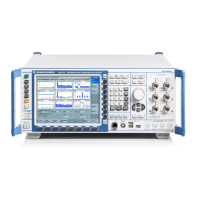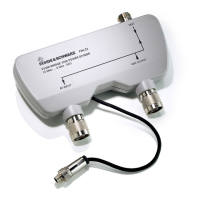System Overview
R&S
®
CMW500
62User Manual 1173.9463.02 ─ 02
The external attenuation also enters into the internal calculation of the maximum input
power that the R&S CMW500 can measure (see "Expected Nominal Power" below).
Frequency-independent attenuations are defined as part of the measurement settings,
refer to the description of the measurement application. Frequency-dependent correction
tables are administrated and activated/deactivated only via remote commands
(...:FDCorrection:...).
While a correction table is active for the connector currently used by an application, the
GUI of the application displays the table name together with the frequency-independent
attenuation setting.
The table entries can be displayed by clicking the button "FDCorr!".
Expected Nominal Power
Defines the nominal power of the RF signal to be measured. The nominal power should
be set in accordance with the actual transmitter output power of the DUT; an additional
"External Attenuation" (see above) can be used to compensate for the loss in the test
setup. Some measurements provide additional parameters to account for variations of
the signal power (e.g. the "User Margin" for the GPRF Power measurement).
With an inappropriate setting of the expected nominal power, the measurement results
generally deteriorate:
●
If the "Expected Nominal Power" setting is too low, the RF input connector is over-
driven. This can cause unwanted responses in the input path.
●
If the "Expected Nominal Power" setting is too high, the RF input connector is under-
driven, which also impairs the accuracy of the measurements.
Analyzer Frequency
Sets the center frequency of the RF analyzer. This value must be in accordance with the
measured RF signal in order to obtain meaningful measurement results.
4.3.3 Statistical Settings
Measurements generally cover a basic time interval and can be repeated periodically.
The measurement interval depends on the measurement context.
The number of measurement intervals that the R&S CMW500 repeats in order to calcu-
late statistical results is termed "statistic count" or "statistic length" (multi-measurement
count). After one statistic count, the instrument has terminated a basic measurement
cycle ("single-shot" measurement). Measurement cycles can be repeated for an unlimited
number of times, resulting in the "continuous" repetition mode.
Most measurement contexts provide different sets of measurement results; they are cal-
culated as described in section Statistical Results.
The statistical settings described below are set in the configuration dialogs assigned to
each measurement.
Measurements

